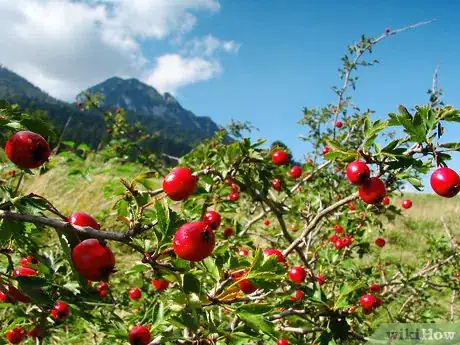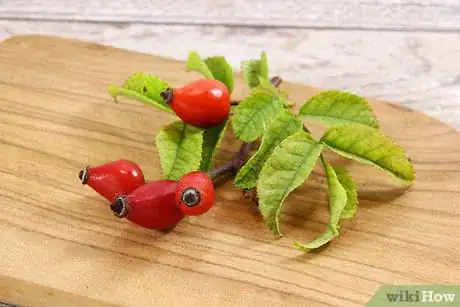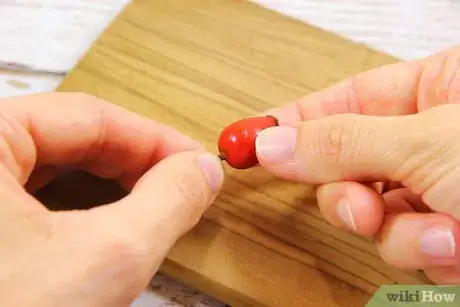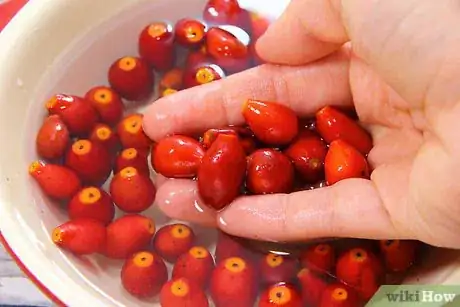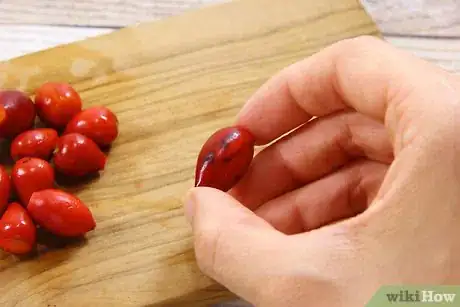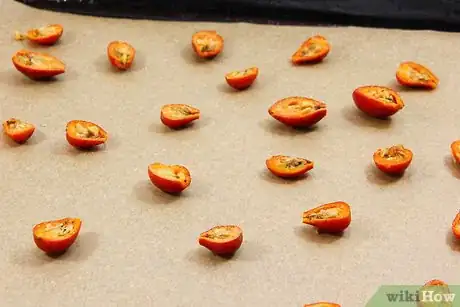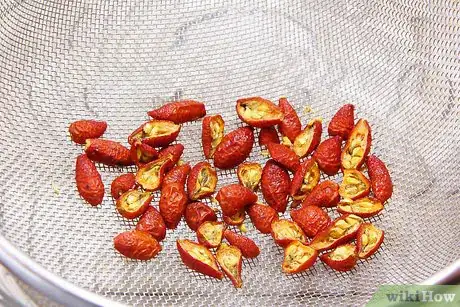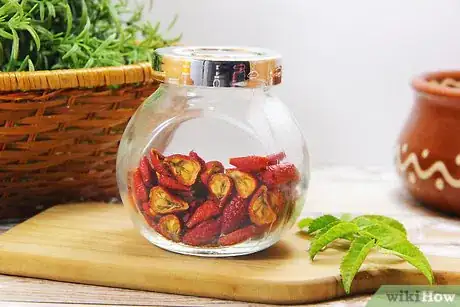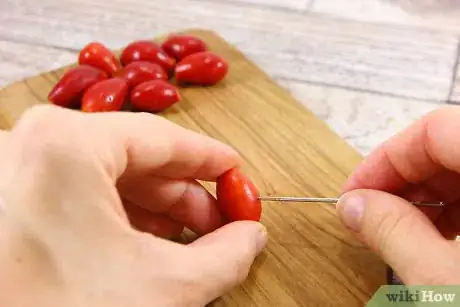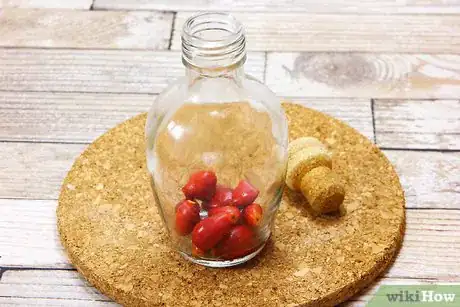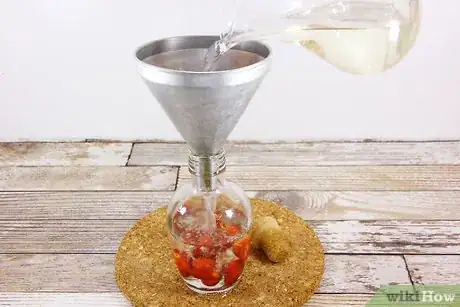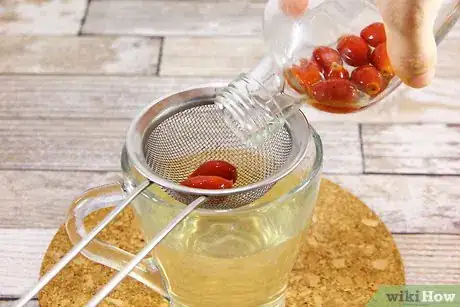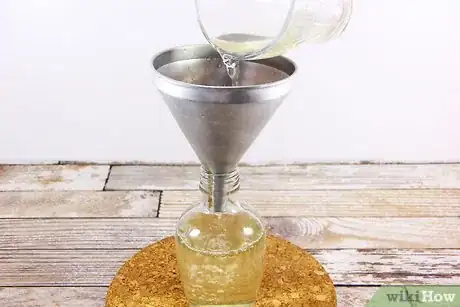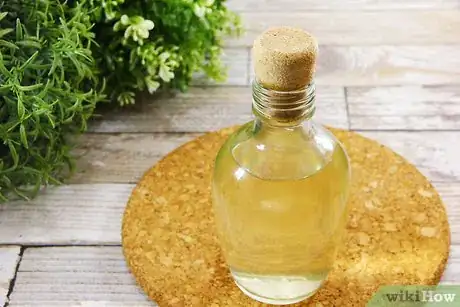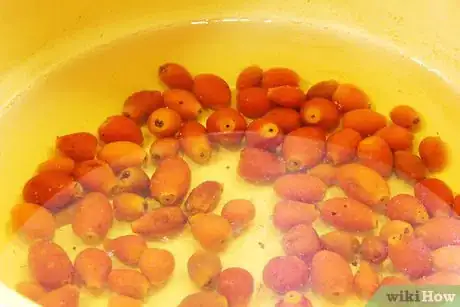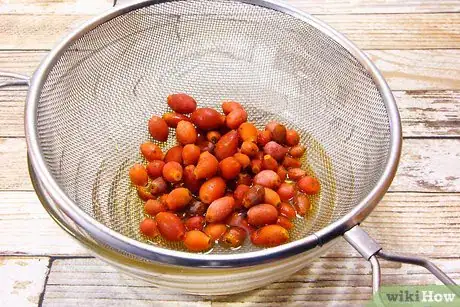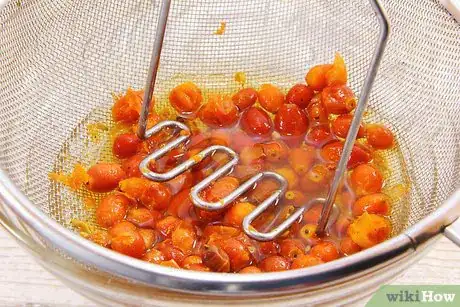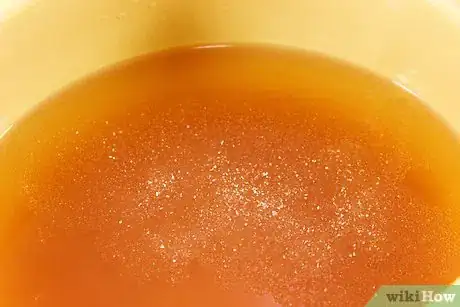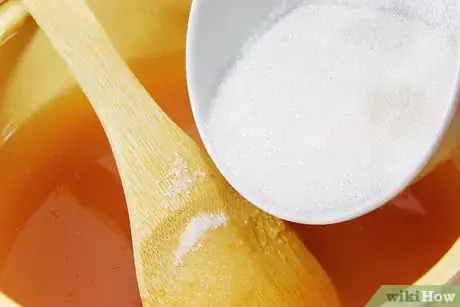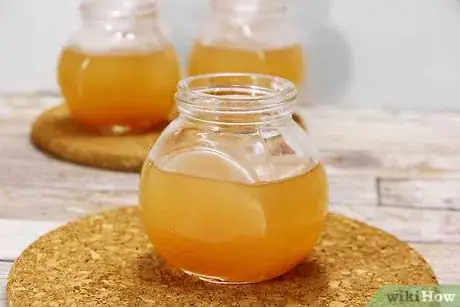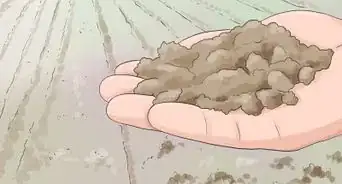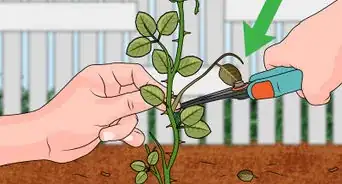This article was co-authored by wikiHow staff writer, Amy Bobinger. Amy Bobinger has been a writer and editor at wikiHow since 2017. She especially enjoys writing articles that help people overcome interpersonal hurdles but frequently covers a variety of subjects, including health and wellness, spirituality, gardening, and more. Amy graduated with a B.A. in English Lit from Mississippi College in 2011 and now lives in her hometown with her husband and two young sons.
There are 16 references cited in this article, which can be found at the bottom of the page.
This article has been viewed 24,653 times.
Learn more...
Rose hips are the small round fruit left over after a rose plant drops its flowers. Rose hips are edible and are highly prized for their nutritious value, especially their vitamin C content. However, they contain small hairs which can cause skin and digestive irritation, so they need to be prepared before they can be used.[1] If you have your own rose bush, there are a number of ways you can preserve your rosehips, including drying, pickling, and turning them into a jelly!
Ingredients
- 2 quarts (1.9 L) fresh rose hips
- 6 cups (1,400 mL) water
- 1⁄2 cup (120 mL) freshly-squeezed lemon juice
- 1 package pectin
- 1⁄4 teaspoon (1.2 mL) butter
- 3.5 cups (830 mL) cups sugar
Steps
Harvesting Rose Hips
-
1Pick the rose hips when they are bright red or orange. If you have a rose bush, leave the flowers on instead of picking them when they have wilted. When the flowers have fallen off and the fruit turns red or orange, you can pick your rose hips by grasping them and giving them a slight twist.[2]
- Pick your rose hips on a dry day to prevent them from molding.
- Start the drying process as soon after picking as possible so your rose hips don’t start to develop brown spots.[3]
-
2Harvest after the first frost for sweeter rose hips. After a frost, the cell walls of the rose hip start to break down, so the fruit becomes sweeter and softer. This is the time when rose hips are considered to be at the peak of their flavor.[4]
- Don't wait too long after the frost, or the rose hips will start to develop brown spots.
Advertisement -
3Pinch the rose hips at the top and bottom to remove the green parts. The place where the rose hip was attached to the stem and, at the other end, the flower, should both come off of the fruit easily if you pinch and twist the green part at either end.[5]
-
4Rinse the rose hips in cold water. Although you shouldn’t use rose hips which have been treated with non-organic chemicals, it’s still a good idea to wash them in case there were any impurities in the environment, including those caused by pollution, bugs, or wild animals.[6]
-
5Sort the rose hips and discard any which are blemished. Look for rose hips which are cracked, soft, or which have brown spots or other blemishes, and toss them out. These may be spoiled or contaminated by insects.[7]
- The best way to do this is to examine them while you are drying them.
Drying Rose Hips
-
1Cut each rose hip in half. Hold the rose hip between your thumb and forefinger on a flat surface, then use a small paring knife to carefully slice the rose hip in half. Some people prefer to scoop the seeds out of the rose hips at this time in order to remove the hairs. However, this is time consuming, and it’s not necessary if you sift the rose hips after they’re dry.
- In addition to being easier, this technique preserves the seeds, which have their own nutritious benefits.[8]
-
2Spread your rose hips on a cookie sheet lined with parchment paper. Try to spread your rose hips in a single, flat layer. If the rose hips are sitting on top of each other, the fruit on the bottom layer will not be able to dry, so be sure they are laying in an even, single layer.[9]
- The parchment paper will help to wick moisture away from the rose hips as they dry.
-
3Leave the rose hips in a dark, well-ventilated area for about 10 days. Your rose hips will dry best if they are out of direct sunlight. You’ll know they’re ready when the rose hips are hard, wrinkly, and have turned a darker color.[10]
- If you need to dry them faster, you can put them in the oven on the lowest setting or you can use a food dehydrator.[11]
-
4Sift the dried rose hips in a sieve to remove the hair. The hairs inside of rose hips are highly irritating to people’s skin, mouths, and digestive systems, so you’ll want to sift your dried rose hips to remove them. Place them in a fine sieve, then shake or tap the sieve so the fine hairs fall through.[12]
-
5Seal the dried rose hips in airtight containers or glass jars. If properly stored, your dried rose hips should last anywhere from 4 months to 1 year. The cooler the storage environment, the longer they will last.[13]
- If you want your rose hips to last for up to 2 years, try putting them in the freezer.[14]
Infusing Rose Hips into Vinegar
-
1Prick 10-12 fresh rose hips all over with a pin. When infusing vinegar with rose hips, you’ll want to leave the fruit whole. Using a small pin, poke little holes all over the fresh rose hips so the vinegar can easily penetrate the fruit.[15]
- Try not to crush the fruit, as this will allow the hairs from the rose hip to get into the vinegar. You’re going to strain the vinegar at the end of the process, though, so don’t worry if it isn’t perfect.
-
2Add the rose hips to a bottle with a tight cork. You may need to add the rose hips one at a time if the bottle has a narrow neck. You’ll need a bottle that will seal tightly, such as a glass bottle with a cork. You could also use a mason jar or a plastic bottle with a tight-fitting lid.[16]
- The rose hip vinegar is a pretty addition to any kitchen, so choose a bottle that you’ll want to display.
-
3Pour 1 cup (240 mL) of cold white wine vinegar over the rose hips. White wine vinegar is, as the name suggest, made from white wine, lending a subtle yet distinctive flavor to this infusion.[17]
- While you can experiment with different vinegars if you like, such as apple cider or balsamic vinegar, the delicate tangy flavor of white wine vinegar balances the tart rose hip flavor the best.
-
4Let the mixture sit for about 4-6 weeks, shaking occasionally. Keep the bottle closed tightly while the rose hips infuse into the vinegar. Once or twice a week, give the bottle a vigorous shake to help the flavors mix evenly.[18]
- It's best to store the mixture out of direct sunlight.
-
5Pass the mixture through a strainer to remove any hairs. Hold a fine mesh strainer over a second jar or bowl, then slowly pour the vinegar through the strainer and into the second container. This should capture any stray seeds or hairs.[19]
- If you don’t have a strainer, you can strain the vinegar through a coffee filter.
-
6Return the mixture to the original container after you have rinsed it. Rinsing the original container will ensure there are no irritating hairs left on the inside of the bottle. If you like, you can strain the mixture a second time as you pour the vinegar back into the bottle.
-
7Store your rose hip vinegar in a cool, dark place. The shelf life of white wine vinegar is almost indefinite, so your rose hip vinegar could last 5-10 years or more. Keep it away from fluctuating heat or direct sunlight to help preserve the flavor.[20]
Preserving Rose Hips in Jelly
-
1Boil 2 quarts (1.9 L) of rose hips in 6 cups (1,400 mL) of water for 1 hour. To make tart, delicious rose hip jelly, start by boiling fresh rose hips to extract all of the juices. Place the rose hips and 6 cups (1,400 mL) of water into a large stock pot and bring it to a rolling boil.[21]
- Stir the mixture occasionally with a long-handled spoon, taking care to avoid the steam.
-
2Pour the mixture through a strainer or cheesecloth. Have a second pot or large bowl handy. Once you remove the rose hips from the stove, pour the mixture through your strainer or cheesecloth into the second container.[22]
- You will likely notice that a great deal of the water has evaporated, which is an expected part of the process.
-
3Mash the rose hips in the strainer and let them drain for an hour. Use a potato masher to mash the rose hips into a rough puree. Leave them in the strainer or the cheesecloth for at least an hour.[23]
- If you like, you can squeeze the cheesecloth or press a flat spoon into the strainer to extract even more of the juice.
-
4Sterilize your canning jars in the dishwasher or oven. Before you put your rose hip jelly into your canning jars, you’ll want to make sure they’re perfectly sterilized. If you have a dishwasher, run them through a cycle on high heat to kill any germs.[24]
- If you don’t have a dishwasher, place the jars in a 200 °F (93 °C) oven for 10 minutes.
-
5Measure the rose hip juice to be sure you have 3 cups (710 mL). Once you have finished straining your mixture, you should have about 3 cups (710 mL) of juice left. This is the amount you will need to make your jelly.[25]
- If you don’t have enough juice, add water, or pour boiling water through the jelly bag until you have enough juice.
-
6Mix your rose hip juice, lemon juice, and pectin in a large, wide pot. If you like, you can use the pot you used earlier in the process. Add the 3 cups (710 mL) of rose hip juice, 1⁄2 cup (120 mL) of freshly-squeezed lemon juice, and 1 package of prepared pectin, which is usually 1.75 ounces, or 49 grams. Stir them together with a long-handled spoon until they are fully blended.[26]
-
7Bring the mixture to a boil, dissolving all of the pectin, then add the sugar. Heat the mixture until it’s just boiling, stirring frequently. You should see the pectin dissolve. Once it’s fully integrated into the juice, stir in 3.5 cups (830 mL) of sugar.
-
8Add the butter once the sugar has dissolved. Continue heating the mixture until the sugar has fully dissolved, then add 1⁄4 tsp (1.2 mL) of butter to the pot.
-
9Bring the mixture to a hard boil for exactly 1 minute. Turn your stove to high heat until you get a hard boil, or one that you can’t decrease by stirring the mixture.[27]
- Do not overcook jelly mixture at this point, or it will scorch and ruin.
-
10Remove the rose hip jelly from the heat and pour it into your jars. Leave about 1⁄2 in (1.3 cm) of space below the rim so the jar can form a vacuum seal.[28]
-
11Seal the jars by boiling them on a rack for 10 minutes. Place the jars in a tall stock pot on a rack. Fill the pot so the jars are beneath 1 inch (2.5 cm) of water and bring the water to a boil for 10 minutes. After the 10 minutes, carefully remove the jars from the water, using tongs or gloves if needed, and let them cool.[29]
- You should hear the jars popping while they cool as the lids seal.
- The jelly will keep almost indefinitely, but it should be refrigerated if the jar doesn’t seal or once it has been opened.
Things You'll Need
Drying Rose Hips
- Small paring knife
- Cookie sheet
- Parchment paper
- Oven or food dehydrator (optional)
- Sieve
- Airtight containers or glass jars
Pickling Rose Hips in Vinegar
- Small pin
- 1 cup (240 mL) white wine vinegar
- Bottle and cork
- Strainer/coffee filter
Preserving Rose Hips in Jelly
- 6 8 fl oz (240 ml) canning jars and lids
- 2 large pots (8 quarts (7.6 L) or more)
- potato masher
- Very fine mesh strainer or 4 layers of cheesecloth
- Stock pot with rack
- Gloves or tongs (optional)
Warnings
- Do not eat rose hips whole, as they can cause digestive irritation.⧼thumbs_response⧽
- Avoid using rose hips from plants that have been treated with non-organic pesticides, herbicides, or fertilizers.⧼thumbs_response⧽
References
- ↑ https://www.webmd.com/vitamins-supplements/ingredientmono-839-rose%20hip.aspx?activeingredientid=839&activeingredientname=rose%20hip
- ↑ http://wildfoodsandmedicines.com/rosehips/
- ↑ https://recipesfromthewild.wordpress.com/rose-hips/
- ↑ https://www.eatweeds.co.uk/rosehip-faq/
- ↑ http://larderlove.com/rosehip-vinegar/
- ↑ https://recipesfromthewild.wordpress.com/rose-hips/
- ↑ https://recipesfromthewild.wordpress.com/rose-hips/
- ↑ https://www.ncbi.nlm.nih.gov/pubmed/16395741?ordinalpos=21&itool=EntrezSystem2.PEntrez.Pubmed.Pubmed_ResultsPanel.Pubmed_DefaultReportPanel.Pubmed_RVDocSum
- ↑ https://www.eatweeds.co.uk/how-to-dry-store-rose-hips-rosa-canina
- ↑ http://wildfoodsandmedicines.com/rosehips/
- ↑ https://recipesfromthewild.wordpress.com/rose-hips/
- ↑ https://www.eatweeds.co.uk/how-to-dry-store-rose-hips-rosa-canina
- ↑ https://recipesfromthewild.wordpress.com/rose-hips/
- ↑ https://www.uaf.edu/files/ces/publications-db/catalog/hec/FNH-00114.pdf
- ↑ http://larderlove.com/rosehip-vinegar/
- ↑ https://www.eatweeds.co.uk/rosehip-vinegar-recipe
- ↑ http://larderlove.com/rosehip-vinegar/
- ↑ http://www.geniuskitchen.com/recipe/rose-hip-vinegar-507611
- ↑ http://www.geniuskitchen.com/recipe/rose-hip-vinegar-507611
- ↑ http://www.eatbydate.com/other/condiments/how-long-does-vinegar-last/
- ↑ https://www.simplyrecipes.com/recipes/rose_hip_jelly/
- ↑ http://www.nakedcuisine.com/harvested/harvest-use-rose-hips/
- ↑ https://www.simplyrecipes.com/recipes/rose_hip_jelly/
- ↑ https://nchfp.uga.edu/publications/nchfp/factsheets/sterilizing.html
- ↑ https://www.simplyrecipes.com/recipes/rose_hip_jelly/
- ↑ .https://www.simplyrecipes.com/recipes/rose_hip_jelly/
- ↑ https://www.simplyrecipes.com/recipes/rose_hip_jelly/
- ↑ https://www.simplyrecipes.com/recipes/rose_hip_jelly/
- ↑ https://www.simplyrecipes.com/recipes/rose_hip_jelly/
- ↑ http://www.cooksinfo.com/rose-hips
About This Article
To prepare rose hips for preserving, pick them when they are bright red or orange, and try to harvest them after the first frost when they're at their sweetest. Pinch the rose hips at the top and bottom to remove the green parts left from the rose bush. Rinse the rose hips thoroughly, then pat them dry and sort through them to remove any which are blemished, bruised, or cracked. For tips on drying your rose hips, keep reading!
